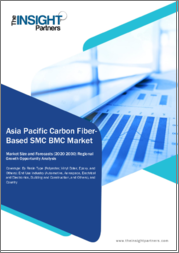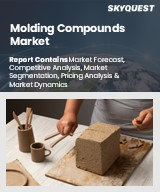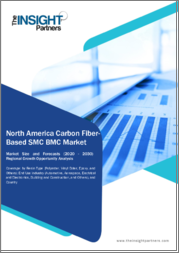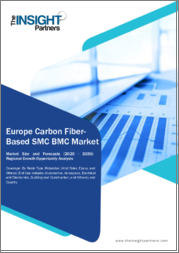
|
시장보고서
상품코드
1510698
아시아태평양의 탄소섬유 기반 SMC 및 BMC 시장 : 예측(-2030년), 지역별 분석 - 수지 유형별, 최종 이용 산업별Asia Pacific Carbon Fiber-Based SMC BMC Market Forecast to 2030 - Regional Analysis - by Resin Type and End-Use Industry |
||||||
아시아태평양의 탄소섬유 기반 SMC 및 BMC 시장은 2022년에 3억 5,259만 달러로 평가되었으고, 2030년에는 6억 53만 달러에 이를 것으로 예측되며, 예측기간 동안 복합 연간 성장률(CAGR)은 6.9%로 성장할 것으로 추정됩니다.
세계 자동차 산업의 성장이 아시아태평양의 탄소섬유 기반 SMC 및 BMC 시장을 뒷받침
유럽의자동차공업회(ACEA)가 발표한 보고서에 따르면 세계 자동차 생산 대수는 2020년부터 2021년에 걸쳐 1.3% 증가했으며, 2021년에는 6,160만대의 승용차를 포함한 7,910만대의 자동차가 세계에서 생산되었습니다. 운송 통계국의 보고서에 따르면 중국은 승용차와 상용차 생산에서 지배적인 시장 중 하나입니다. 중국승용차협회에 따르면 2022년 12월 소매채널을 통해 판매된 승용차는 전년 동월 대비 3% 증가한 217만대였습니다. 국내에서는 2022년 1월부터 12월까지 승용차가 2,054만대 판매되어 전년 동기 대비 1.9% 증가했습니다. 중국승용차협회는 2022년 6월에 시작된 자동차 구매세 감세 정책이 자동차 판매에 크게 기여했다고 합니다. 이 정책은 30만위안( - 4만3,103달러) 미만으로 배기량 2리터 이하의 승용차를 2022년 6월 1일부터 12월 31일 사이에 구입하는 경우 구매세를 50% 감세합니다. 것입니다. 기타 인도는 내수,수출 모두 자동차산업이 호조입니다. 인도의 자동차산업은 중산계급 소득 증가, 투자 증가, 인도 정부의 정책지원으로 성장하고 있습니다. 인도에서는 2000년 4월부터 2022년 12월까지 자동차 부문에 약 341억 1,000만 달러의 누적 주식 FDI가 유입되었습니다. 여러 자동차 제조업체들이 수요 증가에 대응하기 위해 인도 자동차 산업의 다양한 분야에 많은 투자를 시작하고 있습니다.2023년 2월 닛산과 르노는 승용차,전기자동차 시장에서 점유율 확대를 위해 향후 3 - 5년간 인도에 6억 달러를 투자할 계획을 발표했습니다. 이 모든 요인은 인도 자동차 산업의 성장을 가속합니다. 국제자동차공업회 보고서에 따르면 2021년 아시아태평양의 국가들은 4,673만 대의 자동차를 생산했습니다. 국제자동차공업회에 따르면 2022년 일본의 자동차 생산량은 783만대에 달했습니다. 탄소섬유 기반 SMC와 BMC는 가볍고 내구성, 설계 유연성, 온도 변화에 대한 내성, 내화학성을 갖추고 있습니다. 자동차 바디 패널, 구조 부품, 절연 부품 등 다양한 용도에 사용됩니다. 자동차 경량화와 연비 향상에 중점을 두어 자동차 생산용 SMC와 BMC에 대한 수요가 증가하고 있습니다. 전기자동차와 하이브리드 자동차 증가는 전기 부품의 절연용 경량 재료 수요를 더욱 밀어 올리고 있습니다. 따라서 자동차 산업의 성장은 자동차 부품 수요를 촉진하고 예측 기간 동안 탄소섬유 기반 SMC 및 BMC 시장을 밀어 올립니다.
아시아태평양의 탄소섬유 기반 SMC 및 BMC 시장 개요
아시아태평양의 탄소섬유 기반 SMC 및 BMC 시장은 중국, 일본, 인도, 호주, 한국 및 기타 아시아태평양의으로 구분됩니다. 아시아태평양의 시장 성장은 자동차, 건축 및 건설, 전자, 풍력에너지 및 기타 산업의 강한 존재감에 의해 견인되고 있습니다. 아시아태평양은 자동차 제조의 중심지이며 국내외 자동차 제조 업체가 다수 진출하고 있습니다. 중국승용차협회(China Passenger Car Association)가 발표한 보고서에 따르면, 테슬라는 2022년에 8만 3,135대의 중국제 전기차를 납품하고 있으며, 2021년에 비해 전기차 판매가 늘었습니다. 있음을 나타냅니다. 국제자동차공업회 보고서에 따르면 아시아태평양의 각국은 2021년 4,673만대의 자동차를 생산했습니다.자동차, 트럭, 버스, 농업용 차량의 생산에서 SMC 및 BMC 제품은 부품 통합, 내식성, 저중량 등의 이점을 제공합니다. SMC 및 BMC 제품의 장점은 자동차 산업의 성장과 함께 아시아태평양의 시장 성장을 뒷받침합니다. 인구 증가, 주택 건설 활동 활성화, 상업 및 산업 건설 투자 증가로 인한 아시아태평양의 건축 및 건설 산업의 강력한 성장은 이 지역의 탄소섬유 기반 SMC 및 BMC 시장 성장을 뒷받침하고 있습니다. 또한 중국, 일본, 한국은 조선 부문의 주요 국가 중 하나입니다. 중화인민공화국 국가평의회에 따르면 중국 조선 생산량은 2022년 961만 중량톤(dwt)으로 전년대비 2.8% 증가하여 전 세계 46.2%를 차지했습니다. SMC와 BMC 제품은 조선에 적용됩니다. 선박용 섬유 강화 플라스틱은 가볍고 고강도이기 때문에 구조물의 경량화에 큰 잠재력을 가지고 있습니다. 이러한 이유로 아시아태평양의에서는 조선 활동이 활발해지고 있으며 탄소섬유 기반 SMC 및 BMC 시장의 성장을 뒷받침하고 있습니다. 또한 아시아태평양의에서는 지속가능한 에너지 자원에 대한 수요가 있으며, 이는 지역에서 풍력에너지 프로젝트의 성장을 뒷받침하고 있습니다. 국제에너지기구의 보고서에 따르면 2021년 중국은 세계 풍력발전 성장률의 70%를 기록했습니다. 게다가 중국이 2022년 6월에 발표한 14차 5개년 계획에 따르면 중국은 2025년까지 자연에너지에 의한 발전량의 33%를 차지하는 것을 목표로 하고 있으며, 그 중에는 태양광과 풍력 기술의 18%라는 목표도 포함되어 있습니다. 따라서 풍력에너지 분야의 성장으로 아시아태평양의에서는 탄소섬유 기반 SMC 및 BMC 제품에 대한 수요가 증가하고 있습니다.
아시아태평양의 탄소섬유 기반 SMC,BMC 시장 : 수익과 예측(-2030년)(금액)
아시아태평양의 탄소섬유 기반 SMC 및 BMC 시장 세분화
아시아태평양의 탄소섬유 기반 SMC 및 BMC 시장은 수지 유형, 최종 이용 산업, 국가에 따라 분할됩니다.
수지 유형별로, 아시아태평양의 탄소섬유 기반 SMC 및 BMC 시장은 폴리에스터, 비닐 에스테르, 에폭시 등으로 구분됩니다. 2022년에는 폴리에스테르 부문이 가장 큰 점유율을 차지했습니다.
최종 이용 산업별로 아시아태평양의 탄소섬유 기반 SMC 및 BMC 시장은 자동차, 항공우주, 전기, 전자, 건축 및 건설 등으로 분류됩니다. 2022년에는 자동차 부문이 가장 큰 점유율을 차지했습니다.
국가별로 아시아태평양의 탄소섬유 기반 SMC 및 BMC 시장은 호주, 중국, 인도, 일본, 한국 및 기타 아시아태평양의으로 구분됩니다. 2022년 아시아태평양의 탄소섬유 기반 SMC 및 BMC 시장은 중국이 지배적입니다.
Industrial Dielectrics Inc, LyondellBasell Industries NV, Menzolit GmBH, Mitsubishi Chemical Group Corp, Polynt SpA, Teijin Carbon Europe GmbH, Toray TCAC Holding BV, YS ACC Co Ltd는 아시아태평양의 탄소섬유 기반 SMC 및 BMC 시장에서 사업을 전개하고 있습니다. 대기업입니다.
목차
목차
제1장 서론
제2장 주요 요약
- 주요 인사이트
- 시장의 매력
- 시장의 매력
제3장 조사 방법
- 조사 범위
- 2차 조사
- 1차 조사
제4장 아시아태평양의 탄소섬유 기반 SMC 및 BMC 시장 상황
- Porter's Five Forces 분석
- 공급기업의 협상력
- 구매자의 협상력
- 신규 참가업체의 위협
- 경쟁 기업간 경쟁 관계의 강도
- 대체품의 위협
- 생태계 분석
- 원재료 공급업체
- 탄소섬유 베이스 SMC 및 BMC 제조업체
- 유통업체/공급자
- 최종 이용 산업
제5장 아시아태평양의 탄소섬유 기반 SMC 및 BMC 시장 : 주요 시장 역학
- 시장 성장 촉진요인
- 세계 자동차 산업의 성장
- 건설 활동의 활성화
- 경량, 내구성, 내화성 재료 수요 증가
- 시장 성장 억제요인
- 대체 제품의 가용성
- 시장 기회
- 지속가능한 제품의 채용
- 향후의 동향
- 탄소섬유 기반 SMC 및 BMC용 새로운 수지 시스템 개발
- 영향 분석
제6장 탄소섬유 베이스 SMC,BMC 시장 : 아시아태평양의 시장 분석
- 아시아태평양 탄소섬유 기반 SMC 및 BMC 시장 수량
- 아시아태평양 탄소섬유 기반 SMC 및 BMC 시장 수익
- 아시아태평양 탄소섬유 기반 SMC 및 BMC 시장 예측 및 분석
제7장 아시아태평양의 탄소섬유 베이스 SMC 및 BMC 시장 분석 : 수지 유형별
- 폴리에스테르
- 폴리에스테르 시장 : 수량과 예측(-2030년)
- 폴리에스테르 시장 : 수익과 예측(-2030년)
- 비닐에스테르
- 비닐에스테르 시장 : 수량과 예측(-2030년)
- 비닐에스테르 시장 : 수익과 예측(-2030년)
- 에폭시
- 에폭시 시장 : 수량과 예측(-2030년)
- 에폭시 시장 : 수익과 예측(-2030년)
- 기타
- 기타 시장 : 수량과 예측(-2030년)
- 기타 시장 : 수익과 예측(-2030년)
제8장 아시아태평양의 탄소섬유 기반 SMC 및 BMC 시장 분석 : 최종 이용 산업
- 자동차
- 자동차 시장 : 수익과 예측(-2030년)
- 항공우주
- 항공우주시장 : 수익과 예측(-2030년)
- 전기 및 전자
- 전기 및 전자 시장 : 수익과 예측(-2030년)
- 건축 및 건설
- 건축 및 건설 시장 : 수익과 예측(-2030년)
- 기타
- 기타 시장 : 수익과 예측(-2030년)
제9장 아시아태평양의 탄소섬유 기반 SMC 및 BMC 시장 : 국가별 분석
- 아시아태평양
- 호주
- 중국
- 인도
- 일본
- 한국
- 기타 아시아태평양
제10장 경쟁 구도
- 주요 기업별 히트맵 분석
- 기업의 포지셔닝과 집중도
제11장 업계 정세
- 제품 발매
- 합병과 인수
- 사업 확대
- 기타 전략과 전개
제12장 기업 프로파일
- Toray TCAC Holding BV
- Polynt SpA
- Mitsubishi Chemical Group Corp
- Menzolit GmBH
- YS ACC Co Ltd
- LyondellBasell Industries NV
- Teijin Carbon Europe GmbH
- Industrial Dielectrics Inc
제13장 부록
BJH 24.07.18The Asia Pacific carbon fiber-based SMC BMC market was valued at US$ 352.59 million in 2022 and is expected to reach US$ 600.53 million by 2030; it is estimated to grow at a CAGR of 6.9% from 2022 to 2030.
Growing Global Automotive Industry Boosts Asia Pacific Carbon Fiber-Based SMC BMC Market
According to a report published by the European Automobile Manufacturers' Association (ACEA), global motor vehicle production rose by 1.3% from 2020 to 2021, and 79.1 million motor vehicles, including 61.6 million passenger cars, were produced worldwide in 2021. According to a report by the Bureau of Transportation Statistics, China is one of the dominant markets for producing passenger cars and commercial vehicles. According to the China Passenger Car Association, ~2.17 million passenger cars were sold through retail channels in December 2022, an increase of 3% year-on-year. In the country, from January to December 2022, 20.54 million passenger cars were sold, a rise of 1.9% year-on-year. The China Passenger Car Association states that a car-purchase tax cut policy has massively contributed to vehicle sales since its launch in June 2022. The policy reduced the purchase tax by 50% for passenger cars that cost under 300,000 yuan (~US$ 43,103), have engine displacement below 2 liters, and are purchased between June 1 and December 31, 2022. Elsewhere, India has a strong automotive industry in terms of domestic demand and exports. The automotive industry in India is growing due to the rising income of middle-class people, increasing investments, and policy support from the government of India. In the country, the automobile sector received a cumulative equity FDI inflow of about US$ 34.11 billion between April 2000 and December 2022. Several automakers have started investing heavily in various segments of the industry in India to keep up with the growing demand. In February 2023, Nissan and Renault announced their plan to invest US$ 600 million in India over the next 3-5 years to expand their share in the passenger cars & electric vehicles market. All these factors are driving the growth of the automotive industry in India. As per the International Organization of Motor Vehicle Manufacturers report, in 2021, the countries in Asia Pacific produced ~46.73 million units of motor vehicles. According to the International Organization of Motor Vehicle Manufacturers, motor vehicle production in Japan reached 7.83 million units in 2022. Carbon fiber-based SMC and BMC are lightweight and offer durability, design flexibility, tolerance to temperature fluctuations, and chemical resistance. They have various applications such as automotive body panels, structural components, and insulating components. The demand for SMC and BMC for the production of automobiles has increased due to a high emphasis on reducing vehicle weight and enhancing fuel efficiency. The rise in electric and hybrid vehicles has further boosted the demand for lightweight materials for the insulation of electrical components. Thus, the growing automotive industry propels the demand for automotive components, subsequently boosting the carbon fiber-based SMC BMC market during the forecast period.
Asia Pacific Carbon Fiber-Based SMC BMC Market Overview
The Asia Pacific carbon fiber-based SMC and BMC market is segmented into China, Japan, India, Australia, South Korea, and the Rest of Asia Pacific. The market growth in Asia Pacific is driven by the strong presence of the automotive, building & construction, electronics, wind energy, and other industries. Asia Pacific is a hub for automotive manufacturing with a large presence of international and domestic players operating in the region. According to a report published by the China Passenger Car Association, Tesla Inc delivered 83,135 made-in-China electric vehicles in 2022, indicating growth in sales of electric vehicles compared to 2021. The International Organization of Motor Vehicle Manufacturers report states that various countries in Asia Pacific produced ~46.73 million units of motor vehicles in 2021. In the production of cars, trucks, buses, and agricultural vehicles, SMC and BMC products offer advantages such as parts consolidation, corrosion resistance, low weight, and others. Benefits of SMC and BMC products, coupled with the growing automotive industry, propel the market growth in Asia Pacific. The strong growth of the building & construction industry in Asia Pacific due to the growing population, rising residential construction activities, and increasing investments in commercial and industrial construction fuels the carbon fiber-based SMC and BMC market growth in the region. Further, China, Japan, and South Korea are among the major nations in the shipbuilding sector. According to The States Council of The People's Republic of China, the shipbuilding output of China was 9.61 million deadweight tons (dwt) in 2022, accounting for 46.2% of the world's total, up 2.8% year-on-year. SMC and BMC products find application in shipbuilding. Marine fiber-reinforced plastic has great potential for reducing structural weight due to its lightweight and high strength. Thus, the growing shipbuilding activities in the region fuel the carbon fiber-based SMC and BMC market growth in Asia Pacific. Furthermore, Asia Pacific experiences demand for sustainable energy resources, which has propelled the growth of wind energy projects in the region. According to the report by International Energy Agency, in 2021, China registered 70% of the world's wind generation growth. Moreover, as per the 14th Five-Year Plan published by China in June 2022, the country is expected to account for a target of 33% of electricity generation from renewables by 2025, including an 18% target for solar and wind technologies. Hence, the growing wind energy sector increases the demand for carbon fiber-based SMC and BMC products in Asia Pacific.
Asia Pacific Carbon Fiber-Based SMC BMC Market Revenue and Forecast to 2030 (US$ Million)
Asia Pacific Carbon Fiber-Based SMC BMC Market Segmentation
The Asia Pacific carbon fiber-based SMC BMC market is segmented based on resin type, end-use industry, and country.
Based on resin type, the Asia Pacific carbon fiber-based SMC BMC market is segmented into polyester, vinyl ester, epoxy, and others. The polyester segment held the largest share in 2022.
By end-use industry, the Asia Pacific carbon fiber-based SMC BMC market is categorized into automotive, aerospace, electrical and electronics, building and construction, and others. The automotive segment held the largest share in 2022.
Based on country, the Asia Pacific carbon fiber-based SMC BMC market is segmented into Australia, China, India, Japan, South Korea, and the Rest of Asia Pacific. China dominated the Asia Pacific carbon fiber-based SMC BMC market in 2022.
Industrial Dielectrics Inc, LyondellBasell Industries NV, Menzolit GmBH, Mitsubishi Chemical Group Corp, Polynt SpA, Teijin Carbon Europe GmbH, Toray TCAC Holding BV, and YS ACC Co Ltd are some of the leading companies operating in the Asia Pacific carbon fiber-based SMC BMC market.
Table Of Contents
Table of Content
1. Introduction
- 1.1 The Insight Partners Research Report Guidance
- 1.2 Market Segmentation
2. Executive Summary
- 2.1 Key Insights
- 2.2 Market Attractiveness
- 2.2.1 Market Attractiveness
3. Research Methodology
- 3.1 Coverage
- 3.2 Secondary Research
- 3.3 Primary Research
4. Asia Pacific Carbon Fiber-Based SMC BMC Market Landscape
- 4.1 Overview
- 4.2 Porter's Five Forces Analysis
- 4.2.1 Bargaining Power of Suppliers
- 4.2.2 Bargaining Power of Buyers
- 4.2.3 Threat of New Entrants
- 4.2.4 Intensity of Competitive Rivalry
- 4.2.5 Threat of Substitutes
- 4.3 Ecosystem Analysis
- 4.3.1 Raw Material Suppliers
- 4.3.2 Carbon Fiber-Based SMC BMC Manufacturers
- 4.3.3 Distributors/Suppliers
- 4.3.4 End-Use Industries
5. Asia Pacific Carbon Fiber-Based SMC BMC Market - Key Market Dynamics
- 5.1 Market Drivers
- 5.1.1 Growing Global Automotive Industry
- 5.1.2 Rising Construction Activities
- 5.1.3 Increasing Demand for Lightweight, Durable, and Fire-Resistant Materials
- 5.2 Market Restraints
- 5.2.1 Availability of Substitute Products
- 5.3 Market Opportunities
- 5.3.1 Adoption of Sustainable Products
- 5.4 Future Trends
- 5.4.1 Development of Novel Resin Systems for Carbon Fiber-Based SMC and BMC
- 5.5 Impact Analysis
6. Carbon Fiber-Based SMC BMC Market - Asia Pacific Market Analysis
- 6.1 Asia Pacific Carbon Fiber-Based SMC BMC Market Volume (Kilo Tons)
- 6.2 Asia Pacific Carbon Fiber-Based SMC BMC Market Revenue (US$ Million)
- 6.3 Asia Pacific Carbon Fiber-Based SMC BMC Market Forecast and Analysis
7. Asia Pacific Carbon Fiber-Based SMC BMC Market Analysis - Resin Type
- 7.1 Polyester
- 7.1.1 Overview
- 7.1.2 Polyester Market Volume and Forecast to 2030 (Kilo Tons)
- 7.1.3 Polyester Market Revenue and Forecast to 2030 (US$ Million)
- 7.2 Vinyl Ester
- 7.2.1 Overview
- 7.2.2 Vinyl Ester Market Volume and Forecast to 2030 (Kilo Tons)
- 7.2.3 Vinyl Ester Market Revenue and Forecast to 2030 (US$ Million)
- 7.3 Epoxy
- 7.3.1 Overview
- 7.3.2 Epoxy Market Volume and Forecast to 2030 (Kilo Tons)
- 7.3.3 Epoxy Market Revenue and Forecast to 2030 (US$ Million)
- 7.4 Others
- 7.4.1 Overview
- 7.4.2 Others Market Volume and Forecast to 2030 (Kilo Tons)
- 7.4.3 Others Market Revenue and Forecast to 2030 (US$ Million)
8. Asia Pacific Carbon Fiber-Based SMC BMC Market Analysis - End-Use Industry
- 8.1 Automotive
- 8.1.1 Overview
- 8.1.2 Automotive Market Revenue and Forecast to 2030 (US$ Million)
- 8.2 Aerospace
- 8.2.1 Overview
- 8.2.2 Aerospace Market Revenue and Forecast to 2030 (US$ Million)
- 8.3 Electrical and Electronics
- 8.3.1 Overview
- 8.3.2 Electrical and Electronics Market Revenue and Forecast to 2030 (US$ Million)
- 8.4 Building and Construction
- 8.4.1 Overview
- 8.4.2 Building and Construction Market Revenue and Forecast to 2030 (US$ Million)
- 8.5 Others
- 8.5.1 Overview
- 8.5.2 Others Market Revenue and Forecast to 2030 (US$ Million)
9. Asia Pacific Carbon Fiber-Based SMC BMC Market - Country Analysis
- 9.1 Asia Pacific
- 9.1.1 Asia Pacific Carbon Fiber-Based SMC BMC Market Revenue and Forecasts and Analysis - By Countries
- 9.1.1.1 Asia Pacific Carbon Fiber-Based SMC BMC Market Breakdown by Country
- 9.1.1.2 Australia Carbon Fiber-Based SMC BMC Market Volume and Forecasts to 2030 (Kilo Tons)
- 9.1.1.3 Australia Carbon Fiber-Based SMC BMC Market Revenue and Forecasts to 2030 (US$ Million)
- 9.1.1.3.1 Australia Carbon Fiber-Based SMC BMC Market Breakdown by Resin Type
- 9.1.1.3.2 Australia Carbon Fiber-Based SMC BMC Market Breakdown by Resin Type
- 9.1.1.3.3 Australia Carbon Fiber-Based SMC BMC Market Breakdown by End-Use Industry
- 9.1.1.4 China Carbon Fiber-Based SMC BMC Market Volume and Forecasts to 2030 (Kilo Tons)
- 9.1.1.5 China Carbon Fiber-Based SMC BMC Market Revenue and Forecasts to 2030 (US$ Million)
- 9.1.1.5.1 China Carbon Fiber-Based SMC BMC Market Breakdown by Resin Type
- 9.1.1.5.2 China Carbon Fiber-Based SMC BMC Market Breakdown by Resin Type
- 9.1.1.5.3 China Carbon Fiber-Based SMC BMC Market Breakdown by End-Use Industry
- 9.1.1.6 India Carbon Fiber-Based SMC BMC Market Volume and Forecasts to 2030 (Kilo Tons)
- 9.1.1.7 India Carbon Fiber-Based SMC BMC Market Revenue and Forecasts to 2030 (US$ Million)
- 9.1.1.7.1 India Carbon Fiber-Based SMC BMC Market Breakdown by Resin Type
- 9.1.1.7.2 India Carbon Fiber-Based SMC BMC Market Breakdown by Resin Type
- 9.1.1.7.3 India Carbon Fiber-Based SMC BMC Market Breakdown by End-Use Industry
- 9.1.1.8 Japan Carbon Fiber-Based SMC BMC Market Volume and Forecasts to 2030 (Kilo Tons)
- 9.1.1.9 Japan Carbon Fiber-Based SMC BMC Market Revenue and Forecasts to 2030 (US$ Million)
- 9.1.1.9.1 Japan Carbon Fiber-Based SMC BMC Market Breakdown by Resin Type
- 9.1.1.9.2 Japan Carbon Fiber-Based SMC BMC Market Breakdown by Resin Type
- 9.1.1.9.3 Japan Carbon Fiber-Based SMC BMC Market Breakdown by End-Use Industry
- 9.1.1.10 South Korea Carbon Fiber-Based SMC BMC Market Volume and Forecasts to 2030 (Kilo Tons)
- 9.1.1.11 South Korea Carbon Fiber-Based SMC BMC Market Revenue and Forecasts to 2030 (US$ Million)
- 9.1.1.11.1 South Korea Carbon Fiber-Based SMC BMC Market Breakdown by Resin Type
- 9.1.1.11.2 South Korea Carbon Fiber-Based SMC BMC Market Breakdown by Resin Type
- 9.1.1.11.3 South Korea Carbon Fiber-Based SMC BMC Market Breakdown by End-Use Industry
- 9.1.1.12 Rest of Asia Pacific Carbon Fiber-Based SMC BMC Market Volume and Forecasts to 2030 (Kilo Tons)
- 9.1.1.13 Rest of Asia Pacific Carbon Fiber-Based SMC BMC Market Revenue and Forecasts to 2030 (US$ Million)
- 9.1.1.13.1 Rest of Asia Pacific Carbon Fiber-Based SMC BMC Market Breakdown by Resin Type
- 9.1.1.13.2 Rest of Asia Pacific Carbon Fiber-Based SMC BMC Market Breakdown by Resin Type
- 9.1.1.13.3 Rest of Asia Pacific Carbon Fiber-Based SMC BMC Market Breakdown by End-Use Industry
- 9.1.1 Asia Pacific Carbon Fiber-Based SMC BMC Market Revenue and Forecasts and Analysis - By Countries
10. Competitive Landscape
- 10.1 Heat Map Analysis By Key Players
- 10.2 Company Positioning & Concentration
11. Industry Landscape
- 11.1 Overview
- 11.2 Product launch
- 11.3 Mergers and Acquisitions
- 11.4 Expansion
- 11.5 Other Strategies and Developments
12. Company Profiles
- 12.1 Toray TCAC Holding BV
- 12.1.1 Key Facts
- 12.1.2 Business Description
- 12.1.3 Products and Services
- 12.1.4 Financial Overview
- 12.1.5 SWOT Analysis
- 12.1.6 Key Developments
- 12.2 Polynt SpA
- 12.2.1 Key Facts
- 12.2.2 Business Description
- 12.2.3 Products and Services
- 12.2.4 Financial Overview
- 12.2.5 SWOT Analysis
- 12.2.6 Key Developments
- 12.3 Mitsubishi Chemical Group Corp
- 12.3.1 Key Facts
- 12.3.2 Business Description
- 12.3.3 Products and Services
- 12.3.4 Financial Overview
- 12.3.5 SWOT Analysis
- 12.3.6 Key Developments
- 12.4 Menzolit GmBH
- 12.4.1 Key Facts
- 12.4.2 Business Description
- 12.4.3 Products and Services
- 12.4.4 Financial Overview
- 12.4.5 SWOT Analysis
- 12.4.6 Key Developments
- 12.5 YS ACC Co Ltd
- 12.5.1 Key Facts
- 12.5.2 Business Description
- 12.5.3 Products and Services
- 12.5.4 Financial Overview
- 12.5.5 SWOT Analysis
- 12.5.6 Key Developments
- 12.6 LyondellBasell Industries NV
- 12.6.1 Key Facts
- 12.6.2 Business Description
- 12.6.3 Products and Services
- 12.6.4 Financial Overview
- 12.6.5 SWOT Analysis
- 12.6.6 Key Developments
- 12.7 Teijin Carbon Europe GmbH
- 12.7.1 Key Facts
- 12.7.2 Business Description
- 12.7.3 Products and Services
- 12.7.4 Financial Overview
- 12.7.5 SWOT Analysis
- 12.7.6 Key Developments
- 12.8 Industrial Dielectrics Inc
- 12.8.1 Key Facts
- 12.8.2 Business Description
- 12.8.3 Products and Services
- 12.8.4 Financial Overview
- 12.8.5 SWOT Analysis
- 12.8.6 Key Developments



















